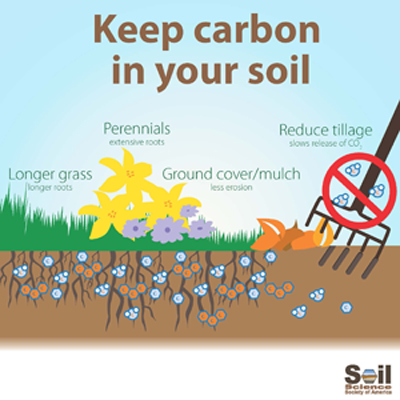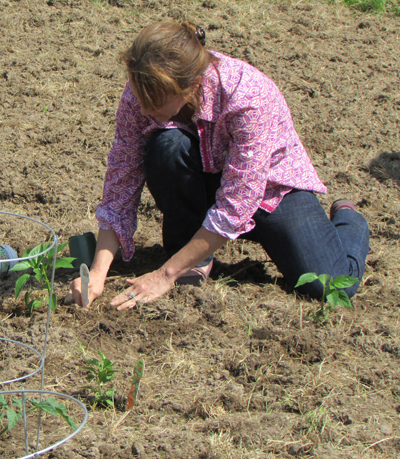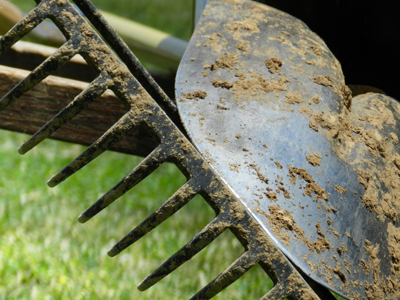There are some practical things you can do in your home or yard to trap some of the carbon from the atmosphere. In our gardens and with our lawns, what we do can make a difference in how the plants and soil interact. And using best practices, in the long-term, can reduce greenhouse gases, and help the environment! First, some basics.

Plants capture carbon dioxide (CO2) from the atmosphere during photosynthesis. They convert the carbon dioxide to simple sugars that plants use for energy and growth, or structural compounds such as fibers and cellulose. This is the first step of what scientists call carbon sequestration – or carbon storage.
When plant roots die, or when plant parts are incorporated into the soil, soil-dwelling insects, worms and microorganisms break down the sugars and other compounds to “eat”. Some of the carbon is released back to the atmosphere as carbon dioxide by the microorganisms. Some remains in the soil. Some of the plant matter is harder to break down, and becomes part of the soil’s organic matter. This is a natural process of carbon sequestration. Plants capture carbon dioxide, a greenhouse gas, and place it in the soil in more stable forms.
Of course, the process works in reverse, too. Those sugar-eating microorganisms do release some carbon dioxide into the atmosphere – just like humans do when we breathe out!
If you think about the two carbon dioxide cycles just described, our goals are to improve plant growth (use of carbon dioxide) and reduce the breakdown of plant residues (release of carbon dioxide). Doing these captures and retains more carbon in the soil.

Here are ways to increase plant growth in your yard that help put more carbon into the ground:
- Allow grass in your yard to grow a bit longer before mowing. This encourages more root growth below ground. Longer grass leaves also means more grassy leaf area – and that means more carbon dioxide is captured from the air. My son lets the grass get a little taller in the spring before he mows. Then he lets the cuttings dry a day before he rakes all of them to use as mulch in his vegetable garden.
- Plant perennials! Plants that live longer accumulate biomass – which is made of carbon (the woody stems or trunks, and their extensive roots.)
- Cover your soil – either with plants, or with mulch. Bare soil is prone to erosion, and does not foster the best plant growth. Mulch conserves moisture and supplies nutrients to the soil.

What can you do to slow the release of carbon dioxide back to the atmosphere? The breakdown of plant residues in the soil is a good and natural process that releases nutrients for use by other organisms and plants. But it can be managed in ways that slows down the amount of carbon dioxide that is also released. The amount of carbon dioxide released is related to the amounts of oxygen, nitrogen and phosphorus in your soil. When you till the soil to control weeds you also put oxygen deeper into the soil. Reduce, or stop, the amount of tilling in your garden. Tilling can help control weeds, but it also can speeds up the decomposition of organic matter and releases a lot of carbon dioxide. In addition, soil organisms often release more carbon dioxide when too much fertilizer is added to the soil – so be sure to test to see if your soil actually needs more nutrients before adding fertilizer. You’ll save money, and help the environment, by only adding as much fertilizer as your garden needs.
Another way to manage your garden is to use mulch to control weeds and conserve moisture. Mulch reduces the contact between the organic material and the soil so that the organisms will take longer to break it down. The mulch will decompose, and its nutrients will be released to the soil but it happens more slowly over the season, actually increasing the organic matter in the soil. If the mulch is left in place from year to year, the soil will be conserved and supplied with nutrients and this long-term view will retain carbon in that garden or flower bed. Sources of mulch can be grass, leaves, composted garden waste or straw. In addition, the leaves that fall in your yard are a wonderful mulch. Plus, they contain carbon already existing in your yard. To learn more, read here.
It may not seem like a homeowner can make a big impact in the quest to reduce carbon dioxide into the atmosphere. But, small steps that encourage plants to grow and slowly add the plant residue back to the soil will convert carbon dioxide into more stable forms of carbon. There are things that you can do that make a difference!
Answered by Jim Friedericks, Outreach and Education, AgSource Laboratories
To read more about carbon capture and release in the Arctic and Subarctic, read here.
To receive notices about future blogs, be sure to subscribe to Soils Matter by clicking on the Follow button on the upper right! Explore more on our webpage About Soils. There you will find more information about Soil Basics, Community Gardens, Green Infrastructure, Green Roofs, Soil Contaminants, materials for Teachers and more.

Your site is an excellent one and all the articles are very useful. Thank you